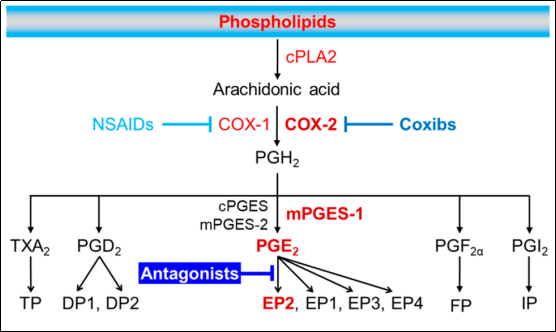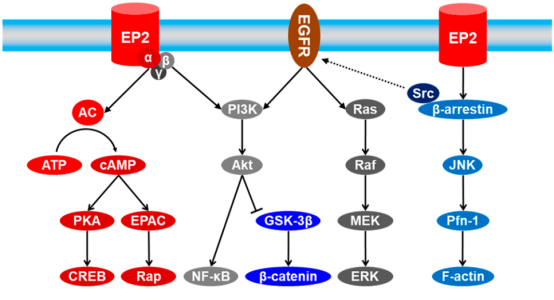EP2 antagonists were discovered ten years ago. What breakthroughs have been made in the treatment of inflammation?
September 24, 2021
Currently, non-steroidal anti-inflammatory drugs (NSAIDs) such as aspirin, ibuprofen, and naproxen play an important role in the clinical treatment of anti-inflammatory. However, NSAIDs are non-specific inhibitors of COX-1/2, so while achieving the purpose of anti-inflammatory and analgesic, they may also cause a wide range of adverse reactions, such as damage to the gastrointestinal tract and cause kidney, cardiovascular and liver dysfunction Wait. Since then, scientists have developed COX-2 selective small molecule inhibitors (coxib). However, data shows that long-term use of coxib is associated with severe cardiac side effects. In order to alleviate the side effects related to non-selective COX inhibition, find new targets and develop a new generation of anti-inflammatory therapies has become the focus of research and development.
1. From COX to EP2
Cyclooxygenase (COX) is the key enzyme for arachidonic acid (AA) to synthesize prostaglandins. There are two known isomers of COX: COX-1 and COX-2, which are coded by ptgs1 and ptgs2, respectively. CoX-1 is expressed in most tissues such as blood vessels, stomach, kidney and platelets, and participates in platelet aggregation, vasomotor, gastric mucosal blood flow and renal blood flow regulation to maintain the stability of the physiological functions of cells, tissues and organs. COX-2 is usually expressed at a low basal level in most normal tissues and organs. Under inflammation or harmful stimuli, arachidonic acid (AA, a 20-carbon fatty acid) is released from the cell membrane through cPLA2, and then converted to PGH2 through COX. Short-lived PGH2 is further catalyzed by tissue-specific prostaglandin synthetase into five types of prostaglandins: PGD2, PGE2, PGF2α, PGI2 and TXA2. The three isozymes responsible for the conversion of PGH2 to PGE2 are mPGES-1, mPGES-2 and cPGES (Figure 1).

Figure 1. COX-2/mPGES-1/PGE2/EP2 signaling pathway (Image source: J. Med. Chem.)
Studies have shown that targeting inducible mPGES-1 can inhibit COX-2 derived PGH2 from synthesizing PGE2, without affecting other types of prostaglandins, and is considered to be more specific than inhibiting COX-2 itself. However, due to the interspecies differences in the sequence and structure of mPGES-1 enzyme, the design and testing of mPGES-1 enzyme inhibitors is very complicated. Therefore, in order to avoid complications caused by the inhibition of PGE2 biosynthesis enzyme, the downstream PGE2 receptor EP2 is considered to be expected as an alternative target and become a more specific target.
2. PGE2/EP2 signal path
The prostaglandin receptor EP2 can form a protein complex with Gs (a heterotrimer composed of α, β, and γ subunits). The activation of the EP2 receptor by PGE2 quickly separates the Gs complex into Gα and Gβγ, which in turn modulates different downstream signaling molecules, which can also interact with many other pathways (Figure 2). The activation of EP2 receptors can be directed to G-protein coupled signaling pathways or independent signaling pathways, which usually interact with other pathways (including EGFR-mediated signaling). Therefore, selective small molecule antagonists can be developed by targeting the EP2 receptor to alleviate the downstream pathological process mediated by the EP2 receptor.

Figure 2. The relationship between EP2 signaling pathway and other pathways (Image source: J. Med. Chem.)
3. Many companies deploy EP2 antagonists
EP2 gene ablation (EP2–/–) is an inhibitory strategy in early research to clarify the physiological and pathological effects of EP2 receptors. Although very useful, it is also complicated by mouse development and other homeostatic adjustments, leading to high blood pressure and reduced litter size. The widely used EP2 receptor small molecule agonists include butoprost, CP-533536, CAY10399, ONO-AE1-259 and C-9 (Figure 3). However, butoprost is only about 18 times more selective for EP2 than EP3; CP-533536 (evatanepag) is about 64 times more selective for EP2 than EP4; CAY10399 and ONO-AE1-259 are highly selective for EP2 But it has a prostaglandin-like structure; C-9 has a high selectivity for other PGE2 receptors, but less than four times the selectivity for TP receptors.
Figure 3. Conventional ligands and compounds that have been used to study EP2 receptors (Image source: J. Med. Chem.)
In addition, there are reports of EP2 positive allosteric modulators with non-prostaglandin structures, and alternative chemical probes are provided to study receptors in the presence of PGE2; however, its pharmacokinetics are uncertain, which hinders the in vivo usage of.
3.1. EP2 antagonist developed by Pfizer
In 2011, Pfizer reported its first EP2 selective antagonist Compound 1 (Figure 4), which showed activity in both in vitro and in vivo tests. In the absence of PGE2 or other agonists, compound 1 does not show any agonist activity, nor does it have any effect on EP2. These results indicate that it specifically counteracts the effects of PGE2 or other agonists acting on the EP2 receptor. Two years later, Pfizer reported its second EP2 selective antagonist, compound 2.
Figure 4. Selective EP2 antagonist developed by Pfizer and tested in animal models (Image source: J. Med. Chem.)
3.2. Compounds developed by Emory
In 2008, researchers at Emory University used a set of cell-based time-resolved fluorescence resonance energy transfer (TR-FRET) to analyze cAMP formation and performed high-throughput screening (HTS) on 262,371 compounds. Due to the lack of truly selective EP2 antagonists at the time, their goal was to develop compounds that selectively inhibit EP2 receptors for the study of brain inflammation caused by long-term epilepsy. Therefore, a series of small molecules have been identified as competitive antagonists of human EP2 receptors. Among them, compound 3 (Figure 5) is the most effective, its functional Schild KB is 2.4 nM, it can antagonize PGE2, its plasma half-life (t1/2) is 0.6 hours, and the brain to plasma ratio is 0.3. Subsequent structure-activity relationships found related derivatives (4-7) (Figure 5).
Figure 5. EP2 antagonists developed by Emory University and extensively evaluated in preclinical models (Image source: J. Med. Chem.)
3.3. Compounds developed by Amgen
In 2015, Amgen researchers identified a new type of EP2 antagonist, compound 8 through high-throughput screening (Figure 6). Compound 8 has mild to moderate potency on human, mouse and rat receptors. In the selectivity test, the selectivity for EP2/EP1 receptor is 400, the selectivity for EP2/EP3 is ~300, but the selectivity for EP2/EP4 (another Gαs-coupled receptor of PGE2) is only 50. In the structure-activity relationship study, compound 9 was discovered.
Figure 6. EP2 antagonist developed by Amgen
4. Summary
After experiencing the side effects caused by long-term use of cyclooxygenase-2 (COX-2) inhibitors, it is widely believed that for the treatment of inflammation, instead of simply shutting down the entire COX cascade, it is better to regulate downstream prostaglandin synthase or Receptor. For a long time, people have attributed the pathogenic effect of COX-2 to PGE2 signaling through its Gas-coupled EP2 receptor subtype. However, truly selective EP2 antagonists did not appear until 2011. These small molecules provide new treatments or research methods that can help researchers better understand EP2 receptors in inflammation-related diseases. Their application in preclinical models has also reshaped people's understanding of PGE2/EP2 signaling as a health and disease inflammation node. This year, on the occasion of the 10th anniversary of the discovery of selective EP2 antagonists, exploring their potential as candidates for next-generation anti-inflammatory therapies has just begun to emerge, and we look forward to benefiting more patients with inflammation in the future.
references
Sluter, Madison N., Ruida Hou, Lexiao Li. et al. EP2 Antagonists (2011–2021): A Decade’s Journey from Discovery to Therapeutics. J. Med. Chem. 2021, 64, 11816–11836








